5: ‘Dr Who and the Daleks’ Film
Events surrounding the first motion picture

Operators
Bruno Castagnoli, Michael Dillon
Robert Jewell, Gerald Taylor
Brian Hands, Eric McKay
Kevin Manser
Len Saunders
Voices
Peter Hawkins
David Graham
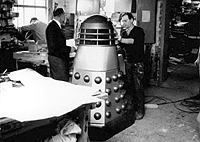
A brand new film Dalek being fabricated at Shawcraft
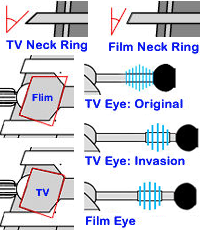

The hemisphere misalignment view from the side 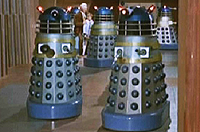
Film Daleks
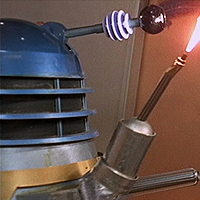
The Blow-Torch Dalek
A New Breed of Dalek
During the Dalekmania of Christmas 1964, two film producers called Joe Vegoda and Milton Subotsky secured the rights to produce a Dalek film based on the first television adventure. With Terry Nation already busy writing the third television serial for his metal creations, Subotsky himself worked on the film script, with some input from David Whitaker. Production was to be handled by one of Vegoda's production companies, AARU, affording it an usually large budget of £180,000.
Cast and crew were assembled in January 1965 and, with William Hartnell tied to his BBC contract, the lead role was given to Peter Cushing. Cushing was a stalwart of the horror films which were very much associated with Amicus, a company of which Subotsky was a director.
The production company AARU required a set of their own Daleks to be built and naturally turned to the company which had produced the original BBC props: Shawcraft.
In February 1965 Shawcraft began work on the new batch of Daleks and it took them roughly one month to complete eight props at an average cost of approximately £350 each. With a Dalek-heavy future on the horizon, and with a tight deadline, Shawcraft took the opportunity to refine their construction techniques, making it quicker and easier to form certain sections.
There were a variety of minor differences with this new batch, such as the angle of the chamfer on the neck rings becoming steeper, and the eye-discs being set slightly further back. The bottom of the eye slot was squared off and stopped higher on movie Daleks, whereas TV props had a rounded slot.
As well as the small differences there were two important construction differences in the movie builds. Firstly, the gunboxes were moulded into the shell of the shoulders themselves, creating a complete fibreglass unit. To achieve this, a change was made to the geometry of the gunboxes whereby the top of the box became parallel to the ground - generally referred to as the "flat-top" gunbox shape.
Secondly, the hemispheres on the skirt were aligned extremely haphazardly - or rather, the holes in the surface of the skirt were cut haphazardly - thus affecting the hemispheres which were pushed through from the inside. It was a flaw which befell all the props. The rear-left column corner panel has hemis that are higher than those on the other panels. However this high placement is exaggerated due to the extremely low positioning of the column to its left.
Director Gordon Flemyng wanted his vision of the adventure to be bolder and brighter than the TV serial, and this was reflected in the appearance of the Daleks. The new props were given the type of enlarged fenders that had been used in the most recent television serial, The Dalek Invasion of Earth. They had simplified guns and large amber lights on the domes. The opportunity was taken to reinstate one of Raymond Cusick's original ideas which was to give some Daleks pincers rather than suckers. In addition, one blue Dalek was fitted with a flexible short silver arm and blow-torch attachment. This 'welder'-Dalek can be recognised in at least two control room scenes, in addition to its main scene cutting down a door.
The Daleks were painted to take full advantage of the colour format of the production. As became tradition in television series, a Black Dalek was leader, possessing a sucker-arm, and its neck rings and skirt hemis were painted an alternating gold and silver. The second-in-command was a Red Dalek with gold trim and black hemis, possessing a pincer claw. The remaining six props were painted in two-tone blue with gold collars, of which two had pincer-claws and one with the blow-torch.
Production got underway at Shepperton on Friday 12th March 1965, with the scenes in the Dalek city being filmed in two chunks throughout April. The first section included the destruction of the control room, after which it was refurbished for certain scenes in which large numbers of Daleks would be needed. For this purpose, a different type of prop had been created...

A dummy Dalek 
The hero props and dummies together for chanting
Background Daleks
For some FX shots, such as the destruction of the Dalek control room, and also the crowd scenes there after its destruction, a batch of 13 Dalek 'extras' were made. Technically these were the first Daleks not to be built by Shawcraft, as they were created at the Plaster shop at Shepperton studios at a cost of £100 each.1
The extras were relatively sophisticated, possessing fully-poseable limbs and flashing lights, but they were cast in large chunks instead of having individual components. They were used most famously in the chanting scene filling up the rear ranks of the Dalek numbers, but they also crop up in scenes were a Dalek is blown up, and also when one is pushed down an open lift shaft.
When seen close up, the moulded nature of the props is easy to spot, since the collars are an extrusion of the shoulders, and the neck is a solid block with the ring and rod details merely a raised surface picked out in paint. At a distance however they looked effective, but can be distinguished at a glance because the collars behind the gunboxes have their inside edges pointing forwards instead of following the line back, giving them a distinctive zig-zag look.
The paint scheme on these props was also subtly different to the main props. The blue used on the head and hemispheres had a touch more red in it, resulting in a slightly purpley shade which looked lighter than the hero props. The finish was also more metallic which meant that under certain lighting conditions would look completely pale in black and white photographs.
Shooting on Dr Who and the Daleks was completed on 23rd April 1965, by which time the publicity was already in full swing. Three Dalek operators with television experience (Robert Jewell, Gerald Taylor and Kevin Manser) had been hired to be the principals in charge of prop movement, and they went straight from Shepperton to rehearsals for studio work on The Chase.
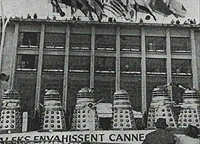
A dozen props at the Cannes film festival 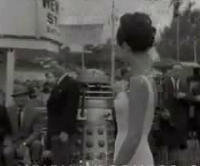
A Dalek at the Variety Club Gala

Roberta Tovey and Daleks in Manchester, August

Keith Stark and Anthony Barber with their prizes 
A flowery Dalek promoting in Jersey
Promoting the Film
There was a great deal of publicity for the Daleks' big-screen debut, starting with BBC interviews with the cast whilst the film was still being shot. Then, on 17th May, a dozen of the props were loaded onto a truck and began a long journey to the south of France. Three days later they arrived for the Cannes Film Festival. This collection of props consisted of four hero props (including the black and red leaders) and many of the extras.
The Cannes publicity work shows the blow-torch Dalek was in a bad way, with its light covers missing, many of the skirt hemispheres had caved in or dropped out of the body and the fender was very badly scuffed. The other props were also showing signs of wear from their shooting schedule plus a lot of transportation.
On the 29th May, a Dalek was needed for the Variety Club star gala This annual event featured many stars of the day and this year was no exception with Liz Frazer, Michael Caine, Bernie Winters, The Beverley Sisters, Stanley Baxter and Cilla Black all present for the day. The Dalek seemed to pick the best job as it is seen judging the beauty contest.
The film premiered on 24th June, two days before the final episode of The Chase was broadcast on television. In addition to the boost from the TV serial, the producers went to great efforts to organise coverage in newspapers and comics, and hype up the film with posters showing long queues outside the cinema.
One of several Dalek-related promotions was in TV21 comic which offered the chance to win a real Dalek to lucky winners. A photo shows the publicity for the launch of the competition taken in July 1965. The Daleks attending are two of the "extras" props. The prop won by Keith Stark of South Woodford was an "extra" and its aforementioned paint-job appears extremely pale in the photos2 however the Red Dalek won by Anthony Barber was a fully-functional hero prop - although it was not the genuine Red Dalek from the film. Young Terrence Worrel also won a fully-working hero prop but again the Black Dalek that he won was not the Black Dalek from the film, it was a hastily repainted blue prop3. The Liverpool Echo also ran a competition in August affording readers the opportunity to win a real Dalek and a Dalek display opened in Lewis's
The national tour featured not only the props themselves but elements of the sets from the film and at the beginning of August a "Dalek City" was opened in Selfridges, London too. Despite the missing eye-stalk the prop (one of the extras with its distinctive zig-zag collars) is in relatively good condition. Roberta Tovey visited both Manchester and Birmingham around the time of her birthday and the Daleks were always in attendance including the real Red Dalek from the film4.
2nd August saw one of the more enterprising efforts at promoting the film. The Jersey Battle of the Flowers first took place on 9th August 1902 in Jersey, as a celebration for the coronation of Edward VII and continued annually ever since stopping only occasionally during the war years. The event featured a huge procession of floats with a floral theme. It was an unusual place to come across an alien invader but nonetheless a car appeared covered with flowers, with a Dalek on top and advertising boards publicised the new film.

Lewis's in 1966

A Dalek in New York, July 1966
After the Film
Once the film frenzy had passed, the guest appearances did not end there. The red and black leaders and a blue prop attended the opening of Lewis's in Stoke-on-Trent in 1966. By this stage their condition was very much worse for wear and they had already started to exhibit some of the careless refurbishments which would become even more puzzling in the 70s on other film props. Aside from the fact that only two eye-rings remain intact, there is a strange white cone-shaped addition to the end of the eye-ball. The black Dalek arm has been replaced with a much thinner rod, and also drilled into the fender are loops for towing the props along. In particular the strange addition to the eye is similar to a series of bizarre modifications to other props which you can read more about on the Nation's Daleks Page. The props had also had repaints which departed from their film appearance, with the Red prop's fender now black instead of gold, and the blue prop's hemispheres were black.
Another photo from May 1966 throws up one final riddle. It was taken in New York, outside the Empire State Building as part of a publicity stunt featuring a college girl, to promote the release of Dr Who and the Daleks in America a year after it had been released in Britain. It shows a Dalek painted a mid-tone colour (presumed to be red but could be dark blue) with plunger (unlike the red film prop which had a pincer), new-style lights, relatively little damage, and silver hemispheres (not black as per the red film Dalek). Its collar screws do not match the red Dalek from the first film either, but there is a more significant feature to distinguish it.
This New York prop has a prominent seam down the centre of the shoulder section with a large blob on the edge. This seam was created in the molding process, however on all the first eight movie props (and the movie-style Dalek and shoulders which appeared in The Chase) this seam has been sanded down so as to be barely noticeable. Therefore props from the first movie can be immediately distinguished from any later builds by the fact that they are smooth between the gunboxes. The seam on this prop proves it was made after the February 1965 batch, and is not one of the hero Daleks from the first film.5
Dr Who and the Daleks was a modest success for Milton Subotsky and Joe Vegoda, but it was helped by a resurgence in popularity of the metal aliens when they has returned to the small screen for the third time in the month preceding the film's release. The production of The Chase was closely linked to the theatrical production and the television props had been forever changed by the arrival of their Technicolour cousins.
- Whilst the Extras were made at Shepperton Plaster shop, the appendages are surely too standardised and accurate not to have been made my Shawcraft? Does this mean that a large number of additional pincers, guns and eyes were ordered up? Does this feed into the idea that by the spring of 1965 the Shawcraft workshop was awash with spare Dalek parts, and thus all sorts of odds and ends started to intermingle?
- The tell-tale 'zig-zag' collars are clearly visible in the photo in which we see Keith receiving his prize. In addition, the odd paint job catches the light making the dome look pale and the skirt completely white. Anthony Barber's Dalek at first glance appears to be the red prop from the film, however his prize had a plunger unlike the real screen prop and the red Dalek hero prop continues to do publicity work after this date. Was this red Dalek therefore another extra? Or was there a full batch ordered by AARU to give away? It seems improbable that they would have spent £350 per prize when the film was taking days to recoup that amount of money - and it seems far more likely that the thirteen extras were used as the prizes.
- A photo showing Terrence Worrel having the top half of his prize lifted over his hear reveals that the body work of the Dalek under the collar remains unpainted where the paint brush would not quite reach and the black paint stops.
- The screws affixing the front of the upper collar are extremely distinctive on the Red Dalek seen in the film. On the Black Dalek for example, the screws over the gunboxes are a fairly typical 27cm apart, whereas on the Red Dalek, there are a mere 16.5cm apart. This narrow configuration is present on all publicity photos of the Red Hero Dalek well into 1966, proving it was not one of ones given away.
- The story goes that AARU got Shawcraft to make "loads" of additional props to promote the film, but photographic evidence to back this up is scarce. The New York picture is the only photo which seems to show a Dalek which wasn't in either of the films.








0 comments:
Post a Comment